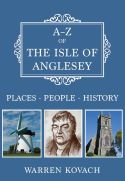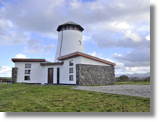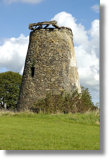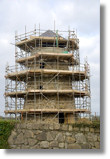Melin Sguthan (Union Mill)
The middle one of the Gaerwen-Pentre Berw mills, this is located on a minor road running north from the village centre off the A5. The exact date of origin is not known but early maps and estate documents suggest that it was built before the nearby Melin Maengwyn.
It is called Gaerwen Mill on the early maps and later became known as the Union Mill after it was purchased by a consortium (union?) of Manchester businessmen in the mid 19th century. The third name, Melin Sguthan, may be derived from the Welsh name for the woodpigeon, ysguthan or y sguthan. Perhaps pigeons were nesting in the abandoned and roofless tower. As recounted on the page about the nearby mill Melin Maengwyn, the name Gaerwen Mill was also often used for that mill, sometimes causing confusion.
Guise and Lees relate in their book that pigs were kept in a low building that once stood next to the mill. Many millers kept pigs in this way, as the pigs would readily eat the grain that the millers sometimes kept as payment for the milling instead of money.
In 1805, when the mill and surrounding land were put up for sale, the land was occupied by the farmer Henry Williams and Nathaniel Morris was running the mill. The 1841 tithe map and apportionment shows that the ultimate landowner of the mill and many other surrounding properties was the Marquess of Anglesey. The mill and farm was then occupied by Owen Jones.
A Robert Jones from Newborough ran the mill for a few years around 1851, but by 1861 the miller was Joseph Williams, brother of William Williams of the other Gaerwen mill, Maengwyn, and son of Owen Williams of Melin Orsedd. Joseph soon moved on to run the watermill at Pwllfanogl, so his brother William took on running this windmill, assisted by his son Owen. They were millers there for many years, until Owen's death in 1892 and his father's demise in 1900. A young Evan Williams, son of a road worker in the village, was then running the mill, but after he married in 1908 he became an insurance agent.
It is not clear who ran the mill in its final years, but it supposedly closed in 1913. During the First World War it was set on fire to help in removing the iron machinery in aid of the war effort. The fire weakened the structure so it had some very evident cracks. Despite this, it was sold (see a photo of the sign outside the mill) and renewed planning permission for conversion into a dwelling was applied for in September 2009. Conversion was carried out in 2012, and the resulting dwelling was listed for sale in October 2012. It again came on the market in 2017.
A detailed archaeological survey of the mill, before and during reconstruction, was done by the Gwynedd Archaeological Trust. You can read it on the Coflein site.
See other images of this windmill at:
- Windmill World
- Anglesey.Info
- People's Collection Wales
- Wikipedia
- Geograph, also here.
- Images taken in 1934 and 1936 from the Donald W. Muggeridge Collection of Mill Photographs, University of Kent, Canterbury
More information at:
![]() Melin Wynt y Craig - Llangefni, or go to gallery.
Melin Wynt y Craig - Llangefni, or go to gallery.
Aerial image
View Windmills of Anglesey in a larger map
A new book by Warren Kovach, author of this web site




